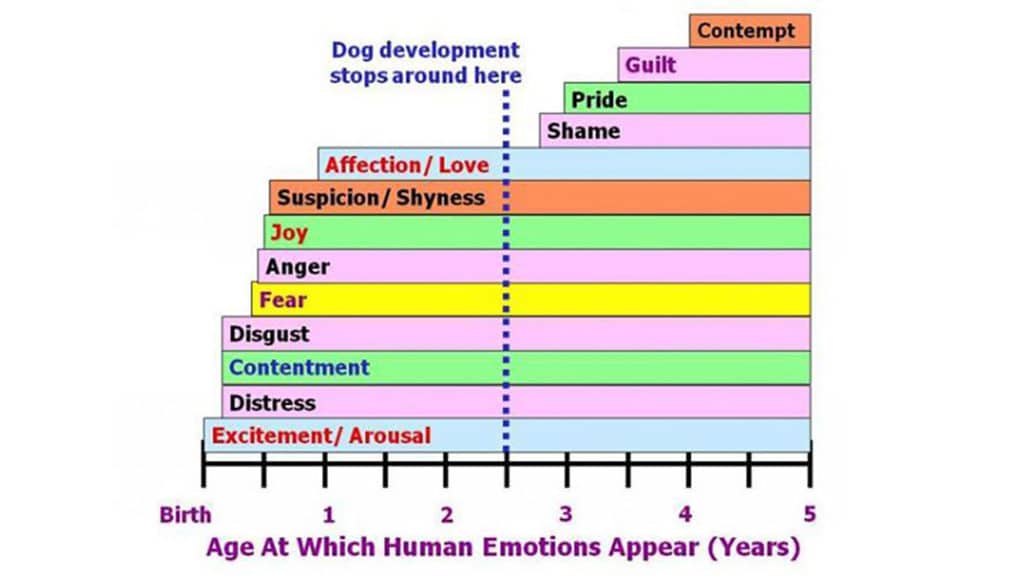Dogs DO In Fact Feel Emotions – According to Science
Dog owners everywhere would agree that their beloved Fido has a plethora of emotions. Science has proven that dogs DO in fact feel emotions, but it’s important to note which emotions they actually feel, and which emotions we think they feel.
The Most Profound Emotion: LOVE
Research has found that dogs release the same “love chemical” as humans do. Oxytocin releases feelings of love and bonding and helps to strengthen relationships.
The Love Between A Dog And A Goat
A researcher named Paul Zak from Claremont Graduate University decided to figure out just how this love chemical worked in non-human test subjects. He found the cutest pair of test subjects at an animal refuge in Arkansas. A small mixed breed terrier, and a goat! That’s right, a goat. Could this get any cuter? Probably not.
Zak allowed the two animals to play with each other for 15 minutes, and once that time was up, took samples to test their levels of Oxytocin. The conclusion was that the two animals were indeed quite fond of one another.
“We found that the dog had a 48 percent increase in oxytocin. This shows that the dog was quite attached to the goat. The moderate change in oxytocin suggests the dog viewed the goat as a ‘friend’,” said Zak, in an article originally published by The Atlantic.
Here’s the interesting (and also adorable) part of the results: the goat’s level of Oxytocin rose by 210%. This study indicated the goat was most likely in love with the terrier.
The One Thing Pet Owners Regret Not Doing Until It’s Too Late
Is your pet safe?
1 in 3 pets will need emergency veterinary treatment each year and it is estimated a pet receives emergency care every 2.5 seconds in the U.S.
The average cost of treating a broken bone in dogs is $2,700. Cancer treatments? Up to $10,000.
It’s why so many pet owners say their biggest regret isn’t the vet bill—it’s not having pet insurance when they needed it most.
Ask yourself: “If an unexpected $5,000 vet bill hit tomorrow, could I afford it?”
If the answer is no, it’s time to get covered.
Take a look at Lemonade. They have a great app that actually works, they have an instant chatbot that is faster and, dare we say it, friendlier than most companies’ “real” customer service and a quick scroll through Reddit will uncover… people are really vibing with this brand.
So go check them out and take a look. It takes less than a minute.
Zak stated in the article, “The only time I have seen such a surge in oxytocin in humans is when someone sees their loved one, is romantically attracted to someone, or is shown an enormous kindness.”
Dogs Feel the Basic Emotions of A Two-Year-Old Child
According to an emotional progression graph from Psychology Today, we can see that dogs feel basic emotions such as love, suspicion, joy, anger, fear, disgust, contentment, distress/anxiety, as well as excitement and arousal. These are similar to the emotions a two-year-old child might experience.
Complex Emotions Are Not Part of A Dog’s Emotional Range
Interestingly, more complex emotions such as guilt, shame, pride, and contempt, are not proven to be part of a dog’s emotional range.
Some pet parents would argue that their dogs are capable of feelings of guilt. However, the signs they are seeing are most likely being mistaken for something else. Here’s an example:
You come home after work and your dog has had an “accident.” Oops! When you find the little pooper, his ears are pinned back, his tail is between his legs, and he looks like a deer caught in the headlights.
Naturally, you come to the conclusion that your dog is showing signs of guilt. However, your dog is actually showing signs of fear. If your dog knows he is not allowed to go potty in the house and has an accident. The fear of being punished will be expressed the moment you return home.
Understanding Our Dogs Emotions Can Help us Take Better Care of Them
If we can understand how our dogs are feeling, we can anticipate and react to their needs better. Without a doubt, this will lead to a healthier and better quality of life for our beloved fur babies. Share your thoughts in the comments below!
80% of Dogs Develop Arthritis or Joint Pain by 7 Years old – Here’s How to Protect Them
Most of us train our dogs when they are puppies to jump up on furniture. We think it’s harmless (and easier than always lifting them), but for dogs, couches and beds are very high compared to the size of their bodies.
Every time they jump it compresses their back and applies enormous force to their joints.
It’s no wonder that an incredible 80% of dogs experience arthritis or joint pain by only 7 years old.
Luckily, there is a vet-recommended solution.
It’s the PawRamp by Alpha Paw. An adjustable ramp that allows dogs to safely get on and off couches and beds. PawRamp makes joining you in bed or on the couch effortless and fun.
As a bonus, you can use code SAVE35 to get $35 off the PawRamp today.















